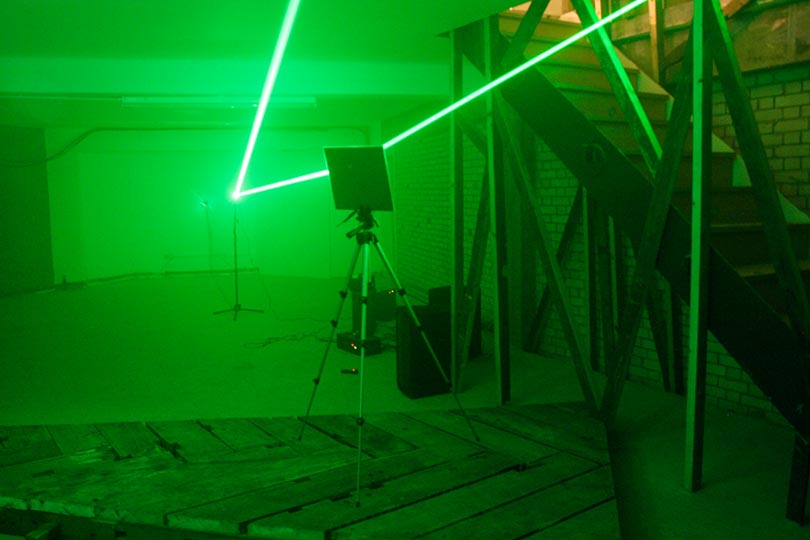Colony was an artist-run ‘takeover’ of a former lighting showroom on Warren Street in Fitzrovia. It was led by the gallery Anarch, which was formerly based in Deptford and now (having closed that space) is ‘roaming’ with this off-site, site-specific commissioned sculpture by artist Andrew Cross. Gallery director Jude Bennett assembled a squad of artist foot troops, a community of practitioners from drone bands to loopy performance artists, to colonise the space for two weeks of events. You could be forgiven for not attending every evening of what was very nearly a rough and tumble mini arts festival to rival some of the best programming from similarly minded – rarely London based – events (Wysing, Grizedale, Liverpool, Eastside Projects). Those who did attend were witnesses to something special, a shifting space, radically altered by the ideas and interpersonal energy of a programme of almost 30 artists who worked in the space – often simultaneously – in a series of one-day residencies.

Andrew Cross’ commission, a spidery construction of beams punctuated by platforms (a table, a bar) functioned as the ‘stage’ for this diverse group. It would be impossible to perform due critical diligence to all involved. Suffice it to say that some were tidy and elegant: such as Phill Wilson-Perkin and Samantha Taylor’s ephemeral sculpture of a laser arcing through the space between mirrors, gently trembling from tiny speakers vibrating the surfaces, or Marianne Walker’s discreet black drawings. Some were loud, leaving only sonic traces: such as Cheatahs’ 11 guitarists and as many amplifiers each playing one note in homage to Rhys Chatham, the rhythms of each individual guitarist’s strums shifting in and out of phase with each other, and a most incredible effect as the drone fades out one by one and your body is left vibrating from the noise. Or Volume Projects’ varied programme of invited sound performers.

Fog machines seemed a popular theme, employed by at least three artists, in one case to facilitate the projection of Anthony MacCall’s classic ‘Line Describing a Cone’, presented here by the group Annexinema. Some contributions were messy: Jim Woodall’s concrete constructions crumbled under their own weight and hasty construction; Nissa Nishikawa performed a ritual dancing with urban animal totems, seven dancers accompanied by recordings of fox howls moving from hypnotic swoons to frenzied feeding. Some were poetic and slow: Fritz Stolberg’s four channel 8mm projections accompanied by Kohei Matsuda’s ambient guitar work. Some were community oriented: Hector Castells’ performance recounts insurgent gardening in a derelict London estate housing block and accompanied by a hearty paella cooked in the gallery. Food was another prevailing theme with a number of artists (Standart Thinking, Nadege Meriau) preparing meals for the gallery-goers in homage to Gordon Matta-Clark’s FOOD project.

“XI” (for Rhys Chatham). Photo Courtesy Anarch Gallery & Keiko Yamazaki
FOOD, a restaurant of sorts, cofounded by Matta-Clark was intended as a node for the downtown scene of 1970s New York, a shared point for a community of artists to meet, drink and discuss ideas. Colony is self-consciously presided over by Matta-Clark, whose anarchic, anti-establishment, communal spirit is invoked here by a selection of his personal letters, wheat-pasted to the wall in a suitably guerilla fashion. As it happens they are shown here with permission from the artist’s estate, copied from a research trip to Montreal where Matta-Clark’s archives are held at the Centre for Contemporary Architecture. The letters reveal a torrent of ideas – you might puzzle over the practicality of some – and an insatiable desire to assemble people toward a common frenetic goal usually located somewhere far outside the white walls of the gallery.
In 1966, Gustav Metzger and John Latham led a seminar on Destruction in Art in London with an invited host of artistic contributors. The artists participated with lectures, discussions, scheduled happenings and roughly documented, improvised performances, often productive of remnants which when archived became sculptural documents, traces of their gathering. The artists formed the main audience for each other’s work in this three day series of events and the show lives on through crumbling objects and crackly recordings.

For the duration of Colony I’m consistently reminded of these events (FOOD, the DIAS seminar) and left wondering at the state of the arts in central London. James Attlee – amongst other things a Matta-Clark scholar – in an essay commissioned for the event speaks of a time when artists were free to inhabit vacant spaces and organise events like this in the centre of the city without bids for funding and planning permission. In discussion one evening with the artist Ramuntcho Matta, Matta-Clark’s half-brother, a favourite topic was the absurdities of official efforts to inhibit unordinary artistic ventures, parodied by Matta-Clark when he purchased an unusable 12 inch wide strip of land in NYC. This subject motivates Amy Lloyd’s ‘Library of Bureaucratic Absurdity’, which was open for the duration of Colony.

“Modular”. Photo courtesy Anarch gallery & Vikki Chapman
These impromptu efforts to organise are still happening but the context is different, and the Colony event asks whether or not it is still possible and productive to work in such an un-prescribed fashion. Can artistic communities still self-consciously assemble without the thinly veiled desire for commercial validation? And what is the point of doing this? This show proposes there is yet ground to be covered by assembling toward no particular end other than to knock ideas back and forth like a football and enjoy the match.
For a full list of the artists involved please visit Anarch’s website at www.anarch.co.uk

